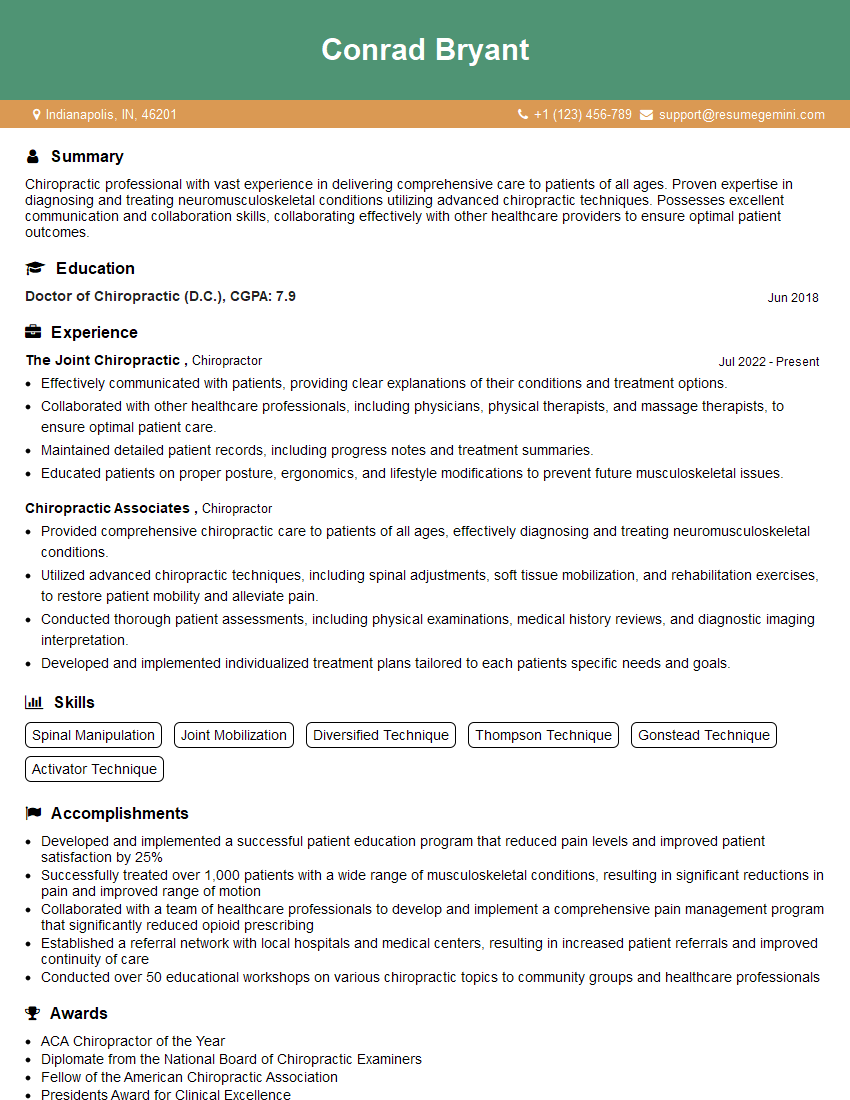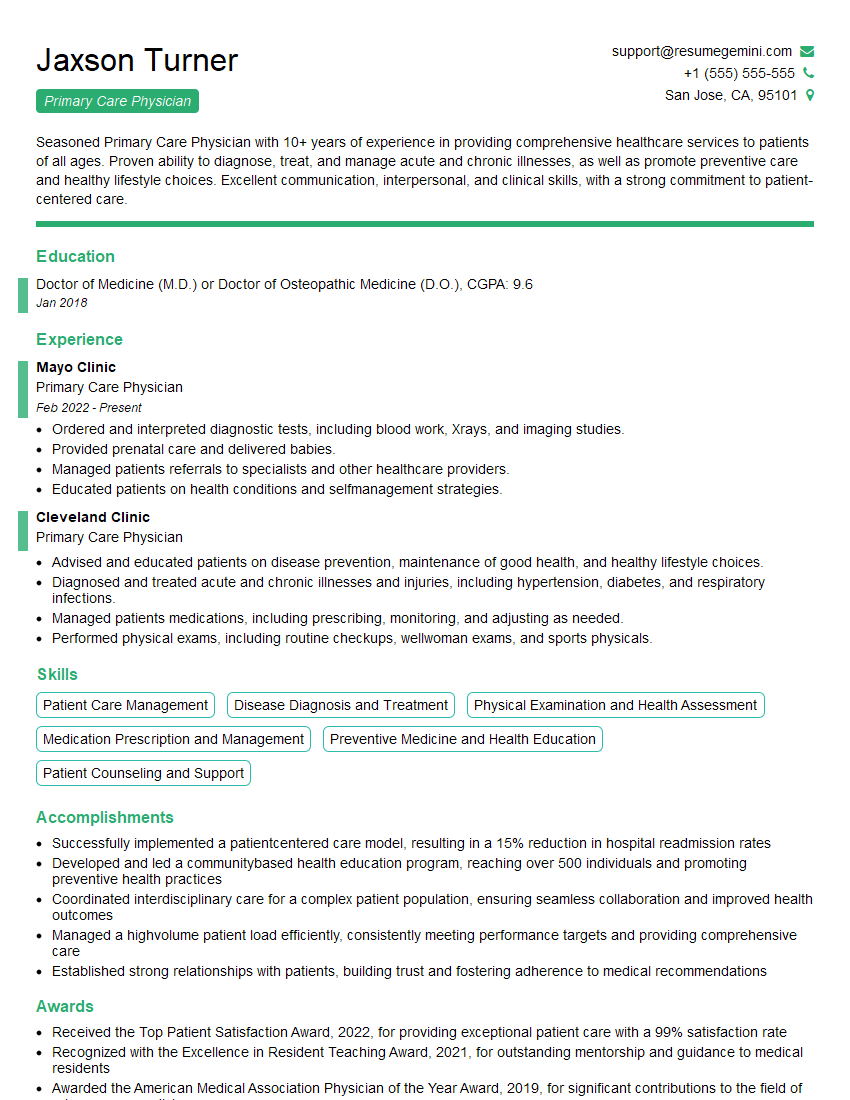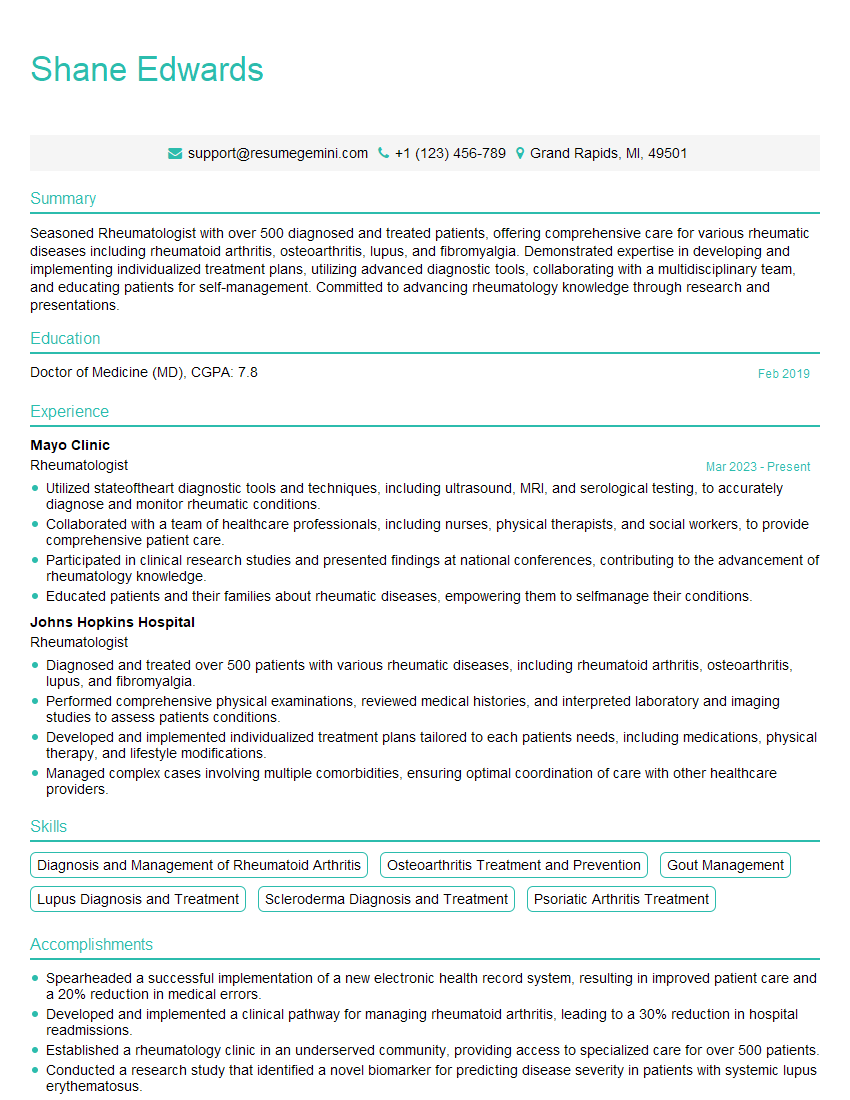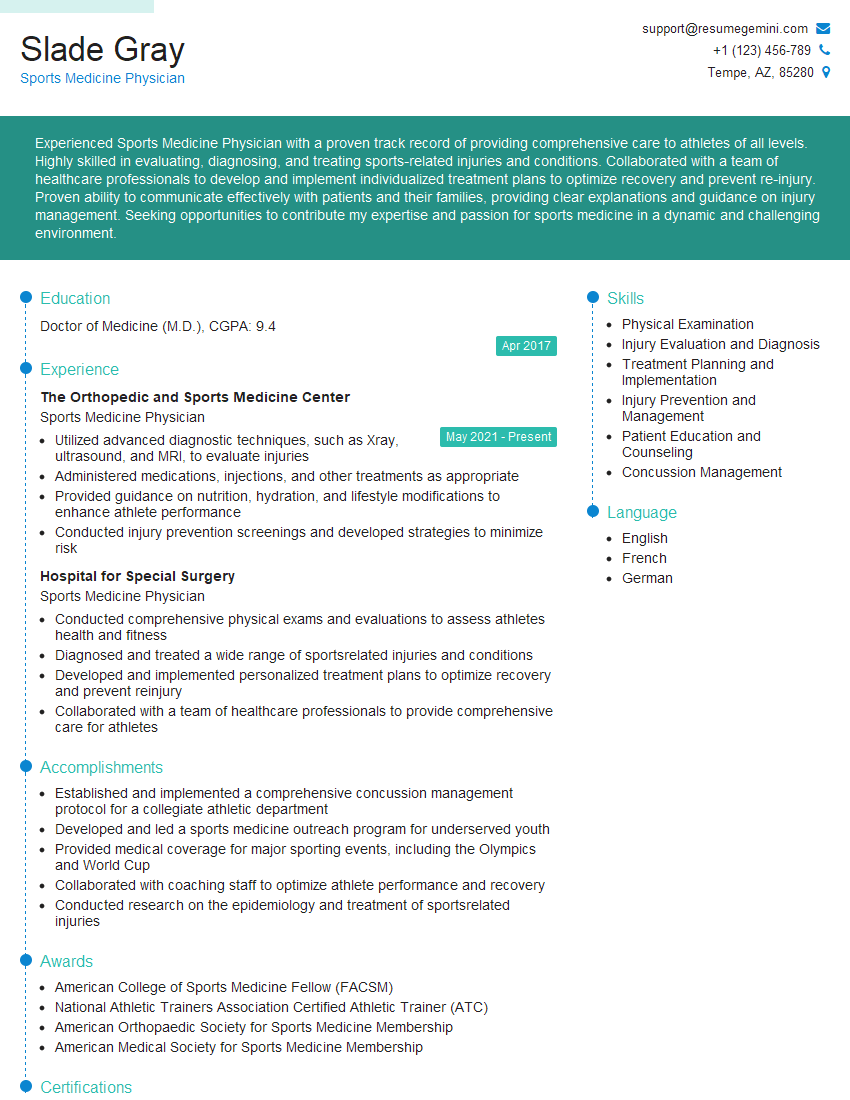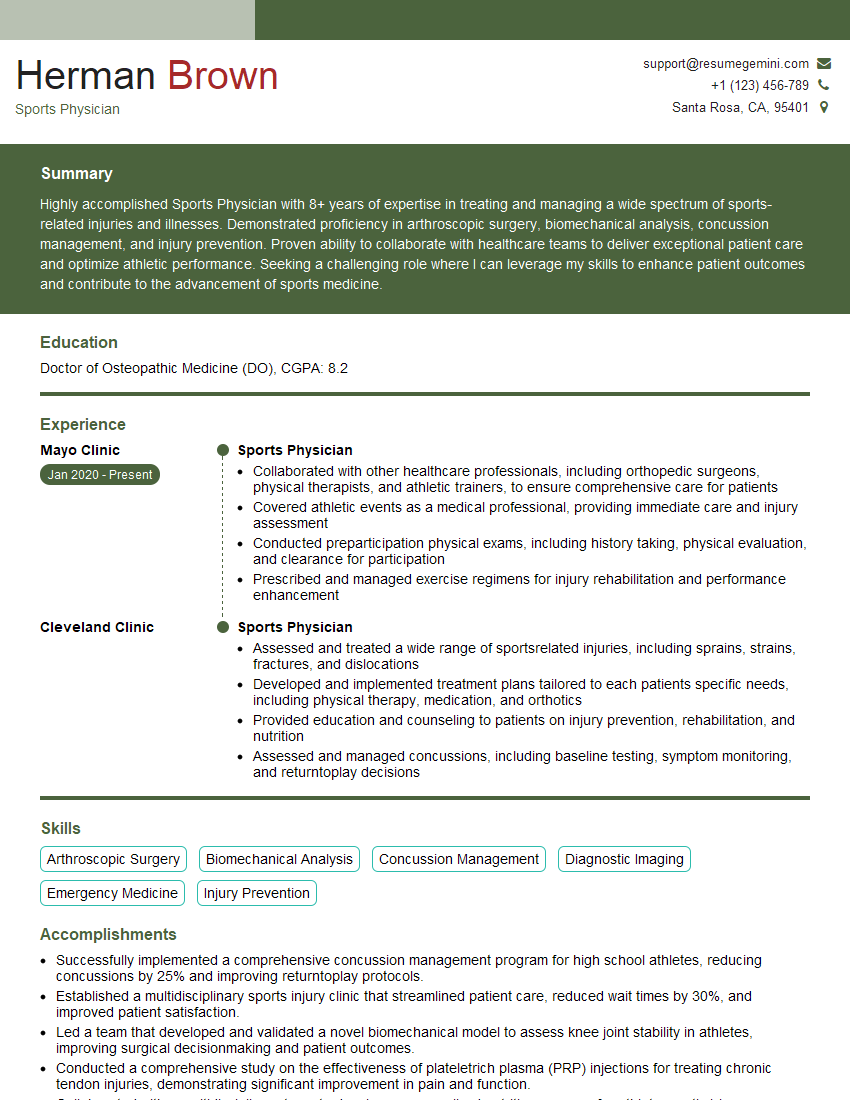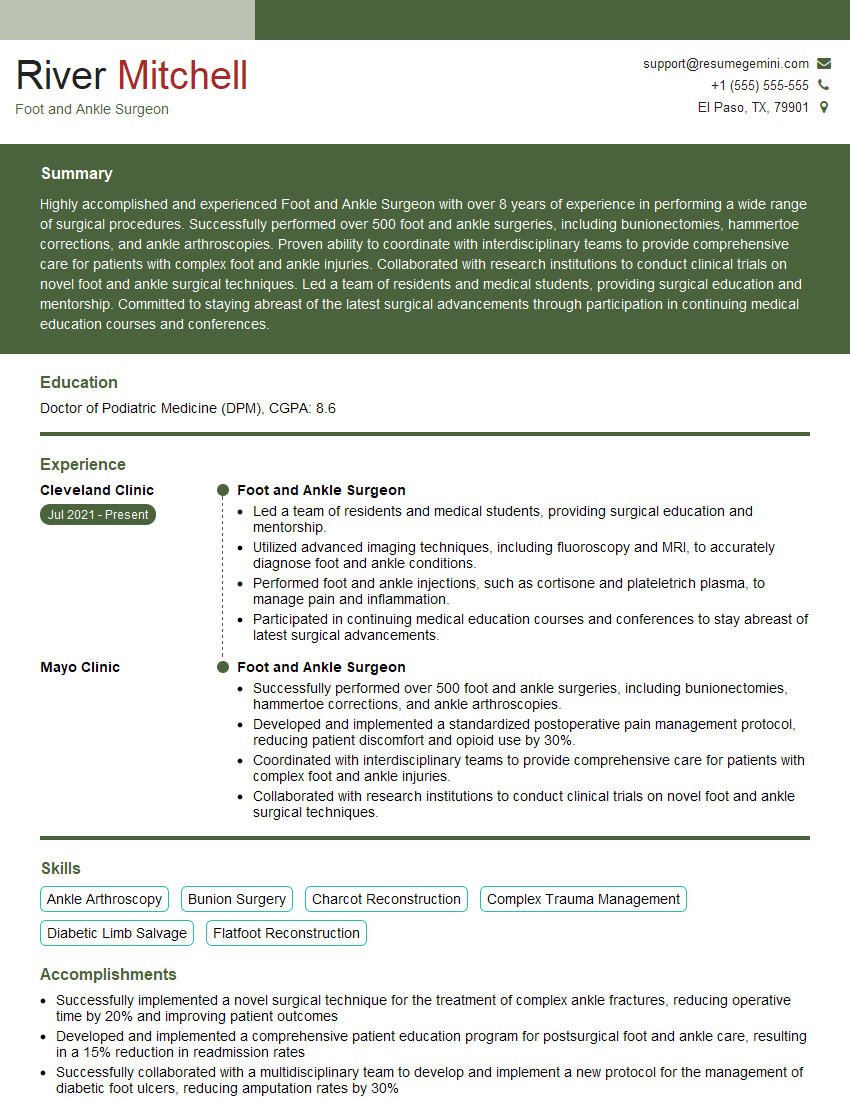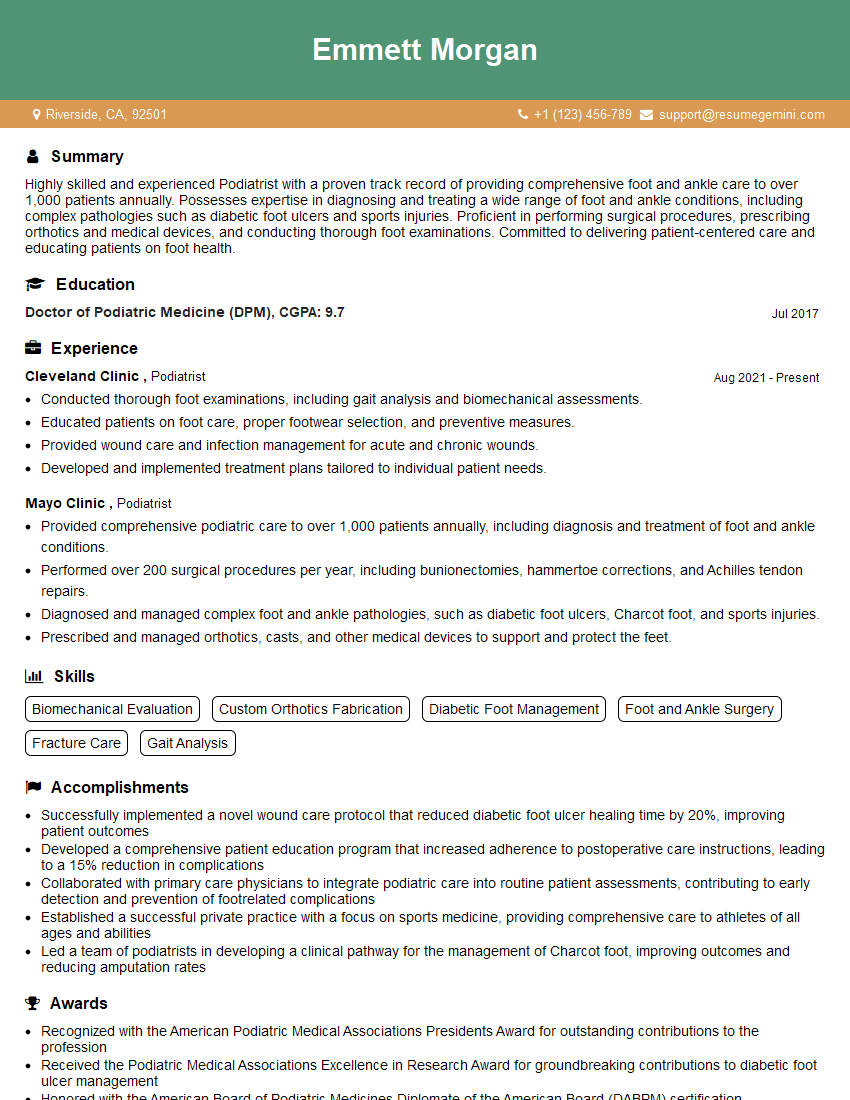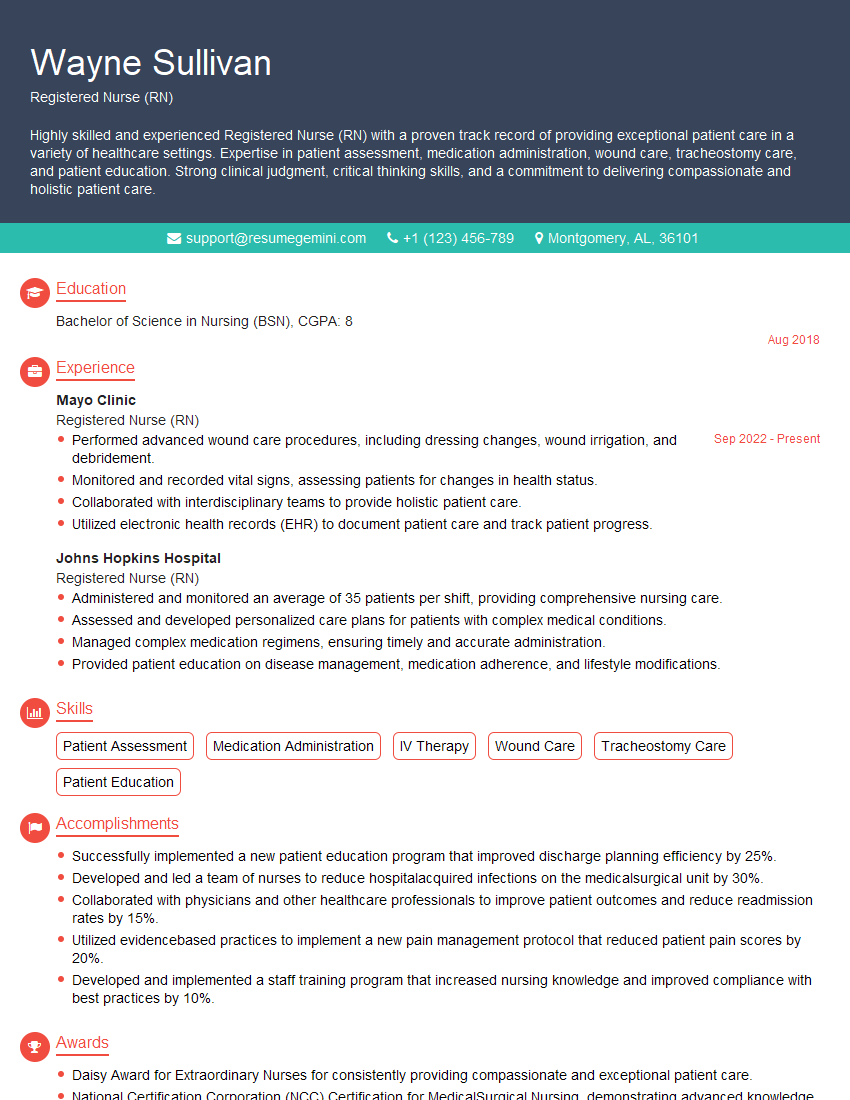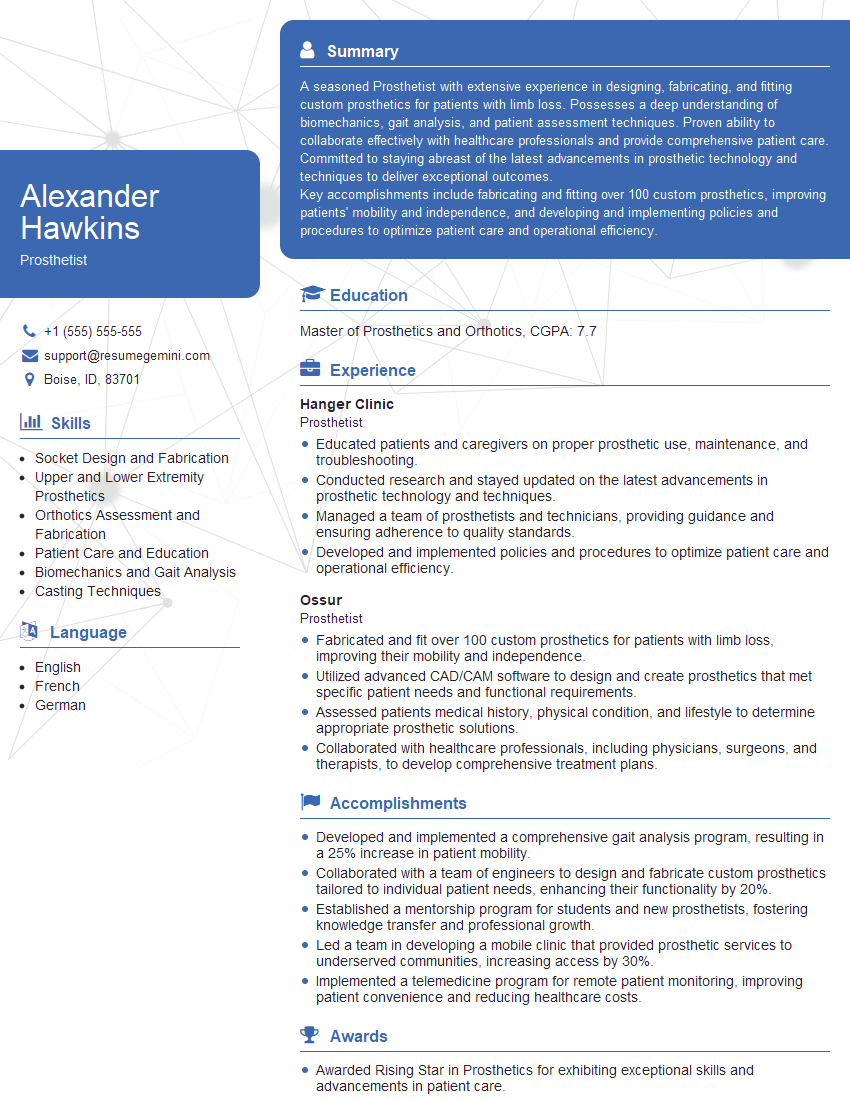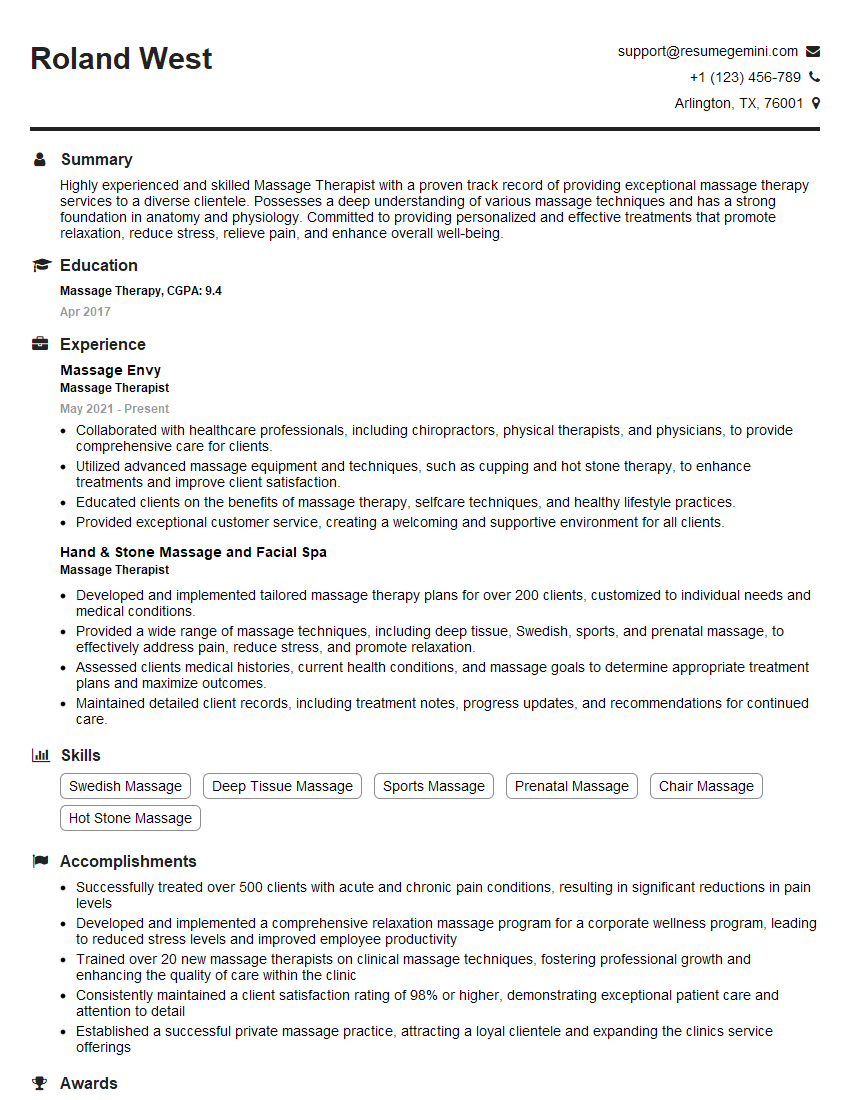Feeling uncertain about what to expect in your upcoming interview? We’ve got you covered! This blog highlights the most important Plantar Fasciitis Treatment interview questions and provides actionable advice to help you stand out as the ideal candidate. Let’s pave the way for your success.
Questions Asked in Plantar Fasciitis Treatment Interview
Q 1. Describe the anatomical structures involved in Plantar Fasciitis.
Plantar fasciitis involves inflammation of the plantar fascia, a thick band of tissue on the bottom of your foot that runs from your heel bone to your toes. It plays a crucial role in supporting the arch of your foot and absorbing shock during activities like walking and running. The key anatomical structures involved are:
- Plantar Fascia: The main player, this thick fibrous band is the source of pain in plantar fasciitis.
- Calcaneus (Heel Bone): The plantar fascia originates from the heel bone’s medial tubercle (a bony prominence on the inside of the heel).
- Proximal Phalanges (Toe Bones): The plantar fascia inserts into the bases of the toes.
- Surrounding Muscles and Tissues: Muscles like the gastrocnemius (calf muscle) and soleus, and surrounding soft tissues (ligaments, tendons) contribute to foot mechanics and can indirectly impact plantar fasciitis.
Understanding these structures helps visualize how inflammation in one area can affect the entire foot’s function.
Q 2. Explain the common causes and risk factors for Plantar Fasciitis.
Plantar fasciitis is often triggered by overuse and repetitive strain. Common causes and risk factors include:
- Overuse: Activities involving prolonged standing, running, or walking, especially on hard surfaces, put excessive stress on the plantar fascia.
- Improper Footwear: Flat shoes or shoes lacking proper arch support increase stress on the plantar fascia.
- Obesity: Excess weight adds extra pressure to the feet.
- Tight Calf Muscles: Tight calf muscles can limit ankle flexibility, increasing strain on the plantar fascia.
- Foot Arch Issues: High arches (pes cavus) or flat feet (pes planus) can alter foot mechanics and increase plantar fascia tension.
- Age: The plantar fascia loses elasticity with age, making it more prone to injury.
- Certain Medical Conditions: Diabetes, rheumatoid arthritis, and other inflammatory conditions increase risk.
For example, a marathon runner who doesn’t properly stretch or wear supportive shoes might experience plantar fasciitis. Similarly, a person who is overweight and stands for long periods might develop the condition.
Q 3. Detail the typical clinical presentation of Plantar Fasciitis.
The classic presentation of plantar fasciitis is pain in the heel, particularly the bottom, often worst in the morning after waking or after periods of rest. The pain usually improves with activity but can return with prolonged standing or activity. Other symptoms can include:
- Heel Pain: Sharp, stabbing pain in the heel, often worse with the first steps in the morning.
- Stiffness: Stiffness in the heel, especially after periods of inactivity.
- Pain with Activity: Pain that worsens with prolonged standing, walking, or running.
- Tenderness to the Touch: Pain when pressure is applied to the plantar fascia near the heel.
- Pain Radiating to the Arch: Pain may spread along the plantar fascia towards the toes.
Imagine the pain as a sharp stabbing sensation when you first step out of bed, gradually easing throughout the day, only to return in the evening after being on your feet for hours.
Q 4. What are the differential diagnoses for Plantar Fasciitis?
It’s crucial to rule out other conditions that may mimic plantar fasciitis. Differential diagnoses include:
- Heel Spurs: Bony growths on the heel bone, often associated with plantar fasciitis, but not always causing pain.
- Stress Fractures: Tiny cracks in the heel bone, usually due to repetitive impact.
- Achilles Tendinitis: Inflammation of the Achilles tendon, causing pain above the heel.
- Tarsal Tunnel Syndrome: Compression of the tibial nerve in the ankle, leading to numbness and tingling in the foot.
- Neuroma: A benign tumor of nerve tissue, often causing burning or tingling sensations in the foot.
- Plantar Fibroma: A benign tumor of the plantar fascia, often causing a thickening or lump in the foot.
A thorough physical examination and imaging studies (X-rays, MRI) are essential to accurately diagnose plantar fasciitis and differentiate it from other conditions.
Q 5. List the various non-surgical treatment options for Plantar Fasciitis.
Non-surgical treatment is the first-line approach for plantar fasciitis. It focuses on reducing pain and inflammation, restoring foot mechanics, and promoting healing. Options include:
- Rest: Avoiding activities that aggravate pain.
- Ice: Applying ice packs for 15-20 minutes several times a day.
- Over-the-Counter Pain Relief: Nonsteroidal anti-inflammatory drugs (NSAIDs) like ibuprofen or naproxen can help reduce pain and inflammation.
- Orthotics: Custom or over-the-counter arch supports to improve foot mechanics and reduce strain on the plantar fascia.
- Night Splints: Splints that hold the foot in a flexed position during sleep to stretch the plantar fascia.
- Physical Therapy: Exercises focusing on stretching and strengthening the plantar fascia, calf muscles, and surrounding tissues.
- Corticosteroid Injections: Injections directly into the plantar fascia can provide temporary pain relief, but this is often considered a last resort before surgery.
A multi-faceted approach, combining several of these options, is generally more effective.
Q 6. Explain the principles behind conservative management of Plantar Fasciitis.
Conservative management of plantar fasciitis aims to reduce pain and inflammation while restoring normal foot biomechanics. The principles are:
- Reduce Inflammation: Using ice, rest, and NSAIDs to decrease swelling and pain.
- Improve Foot Mechanics: Correcting foot posture and biomechanics through orthotics, supportive footwear, and stretching exercises.
- Increase Flexibility and Strength: Stretching tight calf muscles and strengthening the muscles of the foot and lower leg to improve foot stability and reduce strain on the plantar fascia.
- Pain Management: Utilizing various pain management strategies, such as physical modalities and medications, to enable participation in therapeutic exercises.
- Patient Education: Instructing patients on proper footwear selection, activity modification, and self-management strategies.
Think of it like carefully rebuilding a strained muscle – you need to rest it, reduce the inflammation, and then gradually rebuild its strength and flexibility through targeted exercises.
Q 7. Describe the role of stretching and strengthening exercises in Plantar Fasciitis treatment.
Stretching and strengthening exercises are cornerstone treatments in plantar fasciitis. They aim to improve flexibility, reduce muscle imbalances, and enhance foot and ankle stability:
- Stretching Exercises: These focus on stretching the plantar fascia, calf muscles (gastrocnemius and soleus), and Achilles tendon. Examples include towel stretches, calf raises, and plantar fascia self-massage.
- Strengthening Exercises: These target muscles responsible for supporting the arch and stabilizing the foot and ankle. Examples include toe curls, marble pickups, and calf raises.
A crucial element is the gradual progression of these exercises. It’s essential to start gently and increase intensity and duration as tolerated, to avoid re-injury. For example, a patient might initially do toe curls with 5 repetitions, gradually increasing to 20 over several weeks. Similarly, they might start with short periods of calf stretches and gradually hold each stretch for longer durations.
Q 8. What are the indications for using orthotics in Plantar Fasciitis?
Orthotics play a crucial role in Plantar Fasciitis treatment by providing support to the arch of the foot and reducing strain on the plantar fascia. They’re indicated when conservative treatments like rest and stretching haven’t provided sufficient relief. The goal is to correct biomechanical issues that may be contributing to the condition. For example, someone with overpronation (their foot rolls inward excessively when walking) would benefit from orthotics that provide medial arch support and control the amount of pronation. Similarly, someone with a high arch (pes cavus) might need orthotics that provide cushioning and support the plantar fascia directly.
- Custom Orthotics: These are individually molded to the patient’s foot and offer the best support and correction. They are often recommended for individuals with significant biomechanical issues or those who haven’t responded to over-the-counter options.
- Over-the-Counter Orthotics: These are readily available at pharmacies and sporting goods stores, and can provide some level of support, although they may not address individual biomechanical issues as effectively.
The decision on which type of orthotic to use depends on the severity of the condition, the patient’s individual needs, and their response to other treatments. A thorough assessment by a podiatrist or physical therapist is crucial for selecting the appropriate orthotic.
Q 9. Discuss the use of NSAIDs and other medications in managing Plantar Fasciitis pain.
NSAIDs (Non-Steroidal Anti-Inflammatory Drugs) like ibuprofen or naproxen are frequently used to manage pain and inflammation associated with Plantar Fasciitis. They can help reduce pain and improve mobility, allowing patients to engage in therapeutic exercises. These are typically used short-term due to potential side effects like gastrointestinal issues. In some cases, a doctor might prescribe stronger pain relievers like opioids, but these are usually reserved for severe cases and used cautiously because of their addictive potential.
Other medications sometimes considered include corticosteroids, which can be injected directly into the plantar fascia to reduce inflammation. This provides targeted relief, but the effects may not be long-lasting, and repeated injections can weaken the plantar fascia. Ultimately, medication is typically an adjunct to other treatment approaches, not a sole solution.
Q 10. Explain the role of physical therapy modalities (e.g., ultrasound, iontophoresis) in Plantar Fasciitis.
Physical therapy modalities play a vital supportive role in Plantar Fasciitis management, focusing on reducing inflammation, improving flexibility and range of motion, and strengthening the muscles surrounding the foot and ankle. Ultrasound therapy uses sound waves to generate heat deep within the tissues, increasing blood flow and reducing pain and inflammation. Iontophoresis utilizes a low-level electrical current to deliver medication, such as corticosteroids, directly into the plantar fascia for a more targeted anti-inflammatory effect.
In addition to these modalities, physical therapy often involves a structured exercise program including stretching exercises (like plantar fascia stretches and calf stretches), strengthening exercises (e.g., toe raises, heel raises), and possibly neuromuscular re-education techniques (focused on improving gait and movement patterns). For example, a therapist might demonstrate specific exercises targeting the gastrocnemius and soleus muscles, which are often tight in patients with Plantar Fasciitis, thereby reducing strain on the plantar fascia.
Q 11. When is surgical intervention considered necessary for Plantar Fasciitis?
Surgical intervention for Plantar Fasciitis is exceptionally rare and is only considered after conservative treatment options (rest, ice, stretching, orthotics, physical therapy, medication) have failed to provide relief for an extended period (typically 6-12 months or longer), and the pain significantly impacts the patient’s daily life. The decision is made on a case-by-case basis, with a thorough evaluation by a specialist to rule out other underlying conditions.
Factors suggesting surgical consideration might include severe, persistent pain significantly limiting daily function, failure to respond to conservative treatment after a substantial trial period, or evidence of a significant tear or other structural damage to the plantar fascia.
Q 12. Describe different surgical procedures used to treat Plantar Fasciitis.
Surgical procedures for Plantar Fasciitis are designed to address the source of pain and dysfunction. One common procedure is plantar fasciotomy, which involves a small incision to release the tension in the plantar fascia. This can relieve pain and improve flexibility, but it can also weaken the arch and potentially lead to some instability. Another approach is endoscopic plantar fasciotomy, a minimally invasive procedure that requires smaller incisions and results in less scarring compared to open surgery.
Less common procedures might involve addressing associated conditions like bone spurs. The choice of procedure depends on the specific cause and severity of the problem, as determined during a detailed medical examination and imaging.
Q 13. What are the potential complications associated with Plantar Fasciitis and its treatments?
Potential complications associated with Plantar Fasciitis and its treatments are relatively uncommon but need to be considered. Untreated Plantar Fasciitis can lead to chronic pain, limited mobility, and difficulty with weight-bearing activities. With treatment, potential complications may include nerve damage (particularly with injections or surgery), persistent pain, and incomplete healing. In the case of surgery, the risk of infection, excessive scarring, and nerve damage is present, although low with proper surgical technique and post-operative care.
Improper stretching or excessive exercise can also aggravate the condition. It is crucial to follow the guidance of healthcare professionals for optimal outcomes and minimized risk.
Q 14. How do you assess the effectiveness of Plantar Fasciitis treatment?
Assessing the effectiveness of Plantar Fasciitis treatment involves a multi-faceted approach. We look for improvements in pain levels (using pain scales), functional capacity (ability to walk, run, stand for prolonged periods), range of motion, and overall quality of life. Regular follow-up appointments allow for monitoring progress and adjustments to treatment plans as needed.
Objective measures like gait analysis and physical examinations are also helpful. For example, we might use a visual analog scale (VAS) to quantify pain, or assess the patient’s ability to perform specific exercises like heel raises. Ultimately, successful treatment is defined by a reduction in pain, improved function, and the patient’s overall satisfaction with the results.
Q 15. Explain your approach to patient education regarding Plantar Fasciitis.
Patient education is paramount in Plantar Fasciitis management. My approach involves a multifaceted strategy focusing on empowering patients to actively participate in their recovery. I begin by clearly explaining the condition: Plantar Fasciitis is an inflammation of the plantar fascia, a thick band of tissue on the bottom of the foot connecting the heel bone to the toes. I use simple analogies, like comparing the plantar fascia to a stretched rubber band that’s lost its elasticity. We then discuss the contributing factors, which can range from overuse to improper footwear, obesity, and even tight calf muscles. I provide detailed information on self-management strategies, including stretching exercises (specifically focusing on the plantar fascia and calf muscles), appropriate footwear recommendations (emphasizing supportive arch support and cushioning), and the importance of rest and ice. Visual aids like diagrams and videos are also employed to improve understanding and engagement. Finally, I emphasize the importance of consistent adherence to the recommended treatment plan and encourage open communication about any challenges they might encounter.
Career Expert Tips:
- Ace those interviews! Prepare effectively by reviewing the Top 50 Most Common Interview Questions on ResumeGemini.
- Navigate your job search with confidence! Explore a wide range of Career Tips on ResumeGemini. Learn about common challenges and recommendations to overcome them.
- Craft the perfect resume! Master the Art of Resume Writing with ResumeGemini’s guide. Showcase your unique qualifications and achievements effectively.
- Don’t miss out on holiday savings! Build your dream resume with ResumeGemini’s ATS optimized templates.
Q 16. Describe a case where conservative treatment failed, and surgical intervention was required.
I recall a patient, a 45-year-old marathon runner, who presented with severe chronic Plantar Fasciitis. Despite six months of rigorous conservative management including physical therapy, custom orthotics, night splints, NSAIDs, and corticosteroid injections, he experienced persistent, debilitating heel pain limiting his mobility and ability to run. Imaging revealed significant plantar fascia thickening and tearing. After a thorough evaluation and discussion of the risks and benefits, we opted for surgical intervention – a plantar fascia release. Post-surgery, he underwent a comprehensive rehabilitation program focusing on gradual weight-bearing, range-of-motion exercises, and strengthening. His recovery was successful, and he was able to return to running, albeit with modifications to his training regimen.
Q 17. What are the common challenges faced in managing chronic Plantar Fasciitis?
Managing chronic Plantar Fasciitis presents several challenges. Firstly, achieving complete pain relief can be difficult, and many patients experience persistent discomfort despite treatment. Secondly, the diagnosis itself can sometimes be challenging to definitively confirm, particularly in cases with overlapping symptoms. Thirdly, patient compliance is crucial but often difficult to maintain due to the duration of treatment and the need for consistent adherence to self-management strategies like stretching and appropriate footwear. Furthermore, identifying and addressing underlying contributing factors, such as biomechanical issues or systemic conditions, is crucial but may require specialized input from other healthcare professionals. Finally, there’s also the possibility of recurrence, even after successful initial treatment.
Q 18. How do you differentiate between Plantar Fasciitis and other conditions with similar symptoms?
Differentiating Plantar Fasciitis from other conditions with similar symptoms like heel spurs, nerve entrapment (tarsal tunnel syndrome), Achilles tendinitis, or even stress fractures requires a thorough clinical examination. A detailed patient history, including the nature and location of pain, activity levels, and onset of symptoms, is essential. Physical examination involves assessing range of motion, palpating for tenderness along the plantar fascia and surrounding structures, and checking for neurological deficits. Imaging studies like X-rays can help rule out heel spurs or stress fractures. Further investigations like nerve conduction studies might be necessary to exclude nerve entrapment. The key is to consider the totality of clinical findings to arrive at an accurate diagnosis.
Q 19. Discuss the role of patient compliance in successful Plantar Fasciitis management.
Patient compliance is absolutely pivotal in successful Plantar Fasciitis management. The effectiveness of conservative treatments relies heavily on the patient’s commitment to regular stretching, wearing appropriate footwear, maintaining a healthy weight, and avoiding activities that aggravate the condition. I find that regular follow-up appointments and open communication help address any barriers to compliance. We establish realistic goals together, and I provide ongoing support and encouragement throughout the treatment process. For example, I might adjust the exercise regimen based on the patient’s feedback or provide alternative stretching techniques if they’re finding a particular exercise difficult. I also educate patients on the long-term implications of non-compliance, highlighting the potential for chronic pain and functional limitations. A collaborative approach fosters a sense of shared responsibility and enhances the chances of a positive outcome.
Q 20. What are the long-term outcomes you would expect from successful Plantar Fasciitis treatment?
Successful Plantar Fasciitis treatment aims for complete resolution of pain and restoration of normal foot function. Long-term outcomes ideally involve a return to pre-morbid activity levels, with minimal or no residual pain. However, it’s important to manage expectations, as some degree of residual discomfort might persist in some cases, especially in individuals with chronic or severe disease. Maintaining a healthy lifestyle, including regular stretching, appropriate footwear, and weight management, is crucial for preventing recurrence. Long-term follow-up appointments are recommended to monitor progress and address any concerns. Ultimately, the goal is to improve the patient’s quality of life and allow them to participate fully in their daily activities without significant limitations.
Q 21. Describe your experience with specific modalities used in Plantar Fasciitis treatment (e.g., shockwave therapy).
I have extensive experience with various modalities used in Plantar Fasciitis treatment. Extracorporeal Shock Wave Therapy (ESWT) is one I frequently utilize. ESWT involves delivering acoustic shock waves to the affected area to stimulate tissue healing and reduce pain. I’ve found it particularly effective in patients who haven’t responded well to conservative measures. I typically use a focused, low-energy protocol, adjusting parameters based on individual patient response. Other modalities I incorporate include physical therapy, which plays a significant role in improving flexibility, strength, and overall foot mechanics. Custom orthotics offer customized arch support and cushioning to reduce stress on the plantar fascia. In cases of severe inflammation, I might consider corticosteroid injections, but I use them judiciously given the potential side effects. The choice of modality is always individualized and based on a careful assessment of each patient’s unique clinical presentation and response to treatment.
Q 22. How do you determine the appropriate level of activity modification for patients with Plantar Fasciitis?
Determining the appropriate activity modification for Plantar Fasciitis involves a careful assessment of the patient’s pain level, functional limitations, and overall health. It’s not a one-size-fits-all approach. We start by identifying activities that exacerbate the pain. This often includes high-impact activities like running or jumping, prolonged standing or walking, and activities that involve repetitive plantar flexion (pointing the toes).
We then work collaboratively with the patient to create a plan that gradually reduces these aggravating activities. This might involve reducing the duration or intensity of their usual activities, substituting high-impact activities with low-impact alternatives (e.g., swimming instead of running), or incorporating rest periods throughout the day. For example, a patient who runs 5 miles daily might start with 2 miles every other day, gradually increasing the distance and frequency as pain allows. We use a pain scale (e.g., 0-10) to monitor progress and adjust the activity plan accordingly. The goal is to find a balance between sufficient rest to allow healing and maintaining a functional level of activity to prevent deconditioning.
It’s crucial to emphasize listening to their body. Pain is a key indicator. We encourage patients to stop an activity immediately if pain increases beyond a manageable level. Regular follow-up appointments allow for adjustments to the activity modification plan based on the patient’s progress and feedback.
Q 23. What are the potential risks associated with each treatment option for Plantar Fasciitis?
Various treatment options for Plantar Fasciitis each carry potential risks. Let’s examine a few:
- Rest and Activity Modification: While generally safe, excessive rest can lead to muscle atrophy and deconditioning, hindering the recovery process. Improper activity modification can result in continued pain and delayed healing.
- Orthotics: Although generally well-tolerated, ill-fitting orthotics can cause discomfort, skin irritation, or exacerbate existing foot problems. Some patients may experience a temporary increase in pain before adaptation.
- Physical Therapy: While highly effective, some exercises, if performed incorrectly, could worsen the condition. Overexertion during therapy sessions can also lead to increased pain and inflammation.
- Medication (NSAIDs, Corticosteroid Injections): NSAIDs can cause gastrointestinal upset, while corticosteroid injections, while effective for pain relief, carry the risk of Achilles tendon rupture, plantar fascia rupture, or skin atrophy at the injection site. Repeated injections are also discouraged due to the potential for weakening the plantar fascia.
- Surgery: This is rarely necessary but carries risks inherent to any surgical procedure, including infection, nerve damage, and poor healing.
It’s crucial to weigh the benefits and risks of each treatment option carefully with the patient, considering their individual circumstances and medical history. Informed consent is paramount.
Q 24. How would you tailor your treatment approach to different patient populations (e.g., athletes, elderly)?
My treatment approach is tailored to the specific needs of different patient populations. Consider these examples:
- Athletes: For athletes, the goal extends beyond pain relief to a return to their pre-injury activity level. We focus on strengthening exercises, proprioceptive training (improving balance and coordination), and functional rehabilitation to prepare them for the demands of their sport. The recovery timeline might be longer as we aim for a robust return to competition, not just pain-free ambulation.
- Elderly Patients: With elderly patients, we prioritize functional mobility and fall prevention. We may emphasize low-impact exercises, address any contributing factors like decreased flexibility or balance issues, and carefully monitor for adverse events. The treatment might focus more on pain management and improving daily function rather than aggressive rehabilitation.
In both cases, patient education is vital. I ensure they understand their condition, the treatment plan, and the realistic expectations for recovery. This includes managing expectations around activity levels and potential setbacks.
Q 25. Describe your experience working with interdisciplinary teams to manage Plantar Fasciitis.
I frequently collaborate with interdisciplinary teams to manage Plantar Fasciitis. This typically involves podiatrists, physical therapists, and sometimes orthotists. Effective teamwork improves patient outcomes. For example, I might work with a podiatrist to assess the patient’s foot structure and recommend appropriate orthotics, while collaborating with a physical therapist to design a tailored exercise program. Open communication and shared decision-making among team members ensure a comprehensive and coordinated approach, leading to better patient care.
I’ve found that regular team meetings to discuss challenging cases, share updates on patient progress, and coordinate treatment strategies are vital. This collaborative approach ensures that all aspects of the patient’s care are considered and that the treatment plan is optimized for the best results. A clear communication channel between all members of the care team is absolutely necessary for successful patient management.
Q 26. Explain your approach to managing patient expectations regarding Plantar Fasciitis recovery.
Managing patient expectations regarding recovery from Plantar Fasciitis is crucial. I start by explaining the condition clearly, emphasizing that recovery takes time and effort. Realistic timelines are provided, acknowledging that progress can be variable and setbacks can occur. I explain that complete pain resolution might not always be achievable, but significant improvement in function and reduction of pain is the common goal.
I use patient-friendly language, avoiding medical jargon, and encourage questions. I frequently use analogies to help them understand, such as comparing the healing process to mending a tear in a fabric. I emphasize the importance of adherence to the treatment plan, including activity modifications, exercises, and any prescribed medications or orthotics. Regular follow-up appointments provide opportunities to monitor progress, address concerns, adjust the treatment plan as needed, and reinforce positive expectations while acknowledging and addressing any potential frustrations.
Q 27. How do you stay up-to-date with the latest research and best practices in Plantar Fasciitis treatment?
Staying updated on the latest research and best practices is an ongoing process. I regularly review peer-reviewed medical journals such as the Journal of the American Podiatric Medical Association and other relevant publications. I attend conferences and workshops focusing on musculoskeletal disorders and foot and ankle conditions. Participation in professional organizations such as the American Academy of Orthopaedic Surgeons (if applicable based on specialty) provides access to continuing education opportunities and networking with other professionals in the field. This ensures that my knowledge remains current and that I can provide patients with the most evidence-based and effective care.
Furthermore, I actively seek out research studies related to new treatment modalities and technological advancements in the field. This includes evaluating the efficacy and safety of new therapeutic interventions as they become available. Staying informed helps me tailor the most appropriate treatment strategy for each individual patient.
Q 28. Describe a time you had to adapt your treatment plan due to unexpected patient response.
I recall a patient who initially responded well to conservative management for Plantar Fasciitis (rest, ice, NSAIDs, stretching, and orthotics). However, after several weeks, their pain remained persistent, and they were experiencing increased pain at night. The initial treatment plan was not providing the expected level of relief. Upon reevaluation, I discovered they had developed a secondary condition—a stress fracture in their heel. The persistent night pain was a key indicator of a different problem.
This required a significant adaptation of the treatment plan. We immediately stopped the stretching exercises that were likely contributing to the stress fracture, and I referred them for imaging to confirm the diagnosis. The treatment shifted from conservative management of Plantar Fasciitis to managing the stress fracture, which involved immobilization and a modified weight-bearing regimen. This experience highlighted the importance of regularly assessing patients and adjusting the treatment plan based on their response, even if the initial approach appeared to be successful. It reinforced the need for a flexible and adaptable approach to patient care, recognizing that presentations can change, and careful monitoring is crucial.
Key Topics to Learn for Plantar Fasciitis Treatment Interview
- Anatomy and Biomechanics of the Foot: Understanding the structures involved (plantar fascia, heel bone, muscles, etc.) and how they contribute to plantar fasciitis.
- Etiology and Risk Factors: Identifying the causes of plantar fasciitis, including factors like obesity, footwear, and activities.
- Clinical Presentation and Diagnosis: Recognizing the symptoms (pain, stiffness, etc.) and diagnostic methods (physical examination, imaging).
- Conservative Treatment Modalities: Understanding and applying various non-surgical treatments like stretching exercises, orthotics, physical therapy, medications (NSAIDs).
- Surgical Treatment Options: Knowledge of surgical procedures for plantar fasciitis and when they are indicated.
- Post-Treatment Rehabilitation: Developing and implementing rehabilitation plans to optimize patient recovery and prevent recurrence.
- Patient Education and Communication: Effectively communicating diagnosis, treatment plans, and self-management strategies to patients.
- Differential Diagnosis: Distinguishing plantar fasciitis from other conditions with similar symptoms.
- Evidence-Based Practice: Applying current research and best practices in the assessment and management of plantar fasciitis.
- Case Study Analysis: Developing problem-solving skills by analyzing various case scenarios and proposing treatment approaches.
Next Steps
Mastering Plantar Fasciitis Treatment significantly enhances your career prospects in podiatry, physiotherapy, and related fields. A strong understanding of this common condition demonstrates your clinical expertise and ability to effectively manage patient care. To stand out to potential employers, it’s crucial to create a compelling and ATS-friendly resume that highlights your skills and experience. ResumeGemini is a trusted resource that can help you craft a professional and impactful resume tailored to your specific career goals. Examples of resumes tailored to Plantar Fasciitis Treatment professionals are available through ResumeGemini, allowing you to create a document that showcases your unique qualifications and expertise. Invest time in building a strong resume; it’s your first impression on potential employers.
Explore more articles
Users Rating of Our Blogs
Share Your Experience
We value your feedback! Please rate our content and share your thoughts (optional).
What Readers Say About Our Blog
This was kind of a unique content I found around the specialized skills. Very helpful questions and good detailed answers.
Very Helpful blog, thank you Interviewgemini team.


